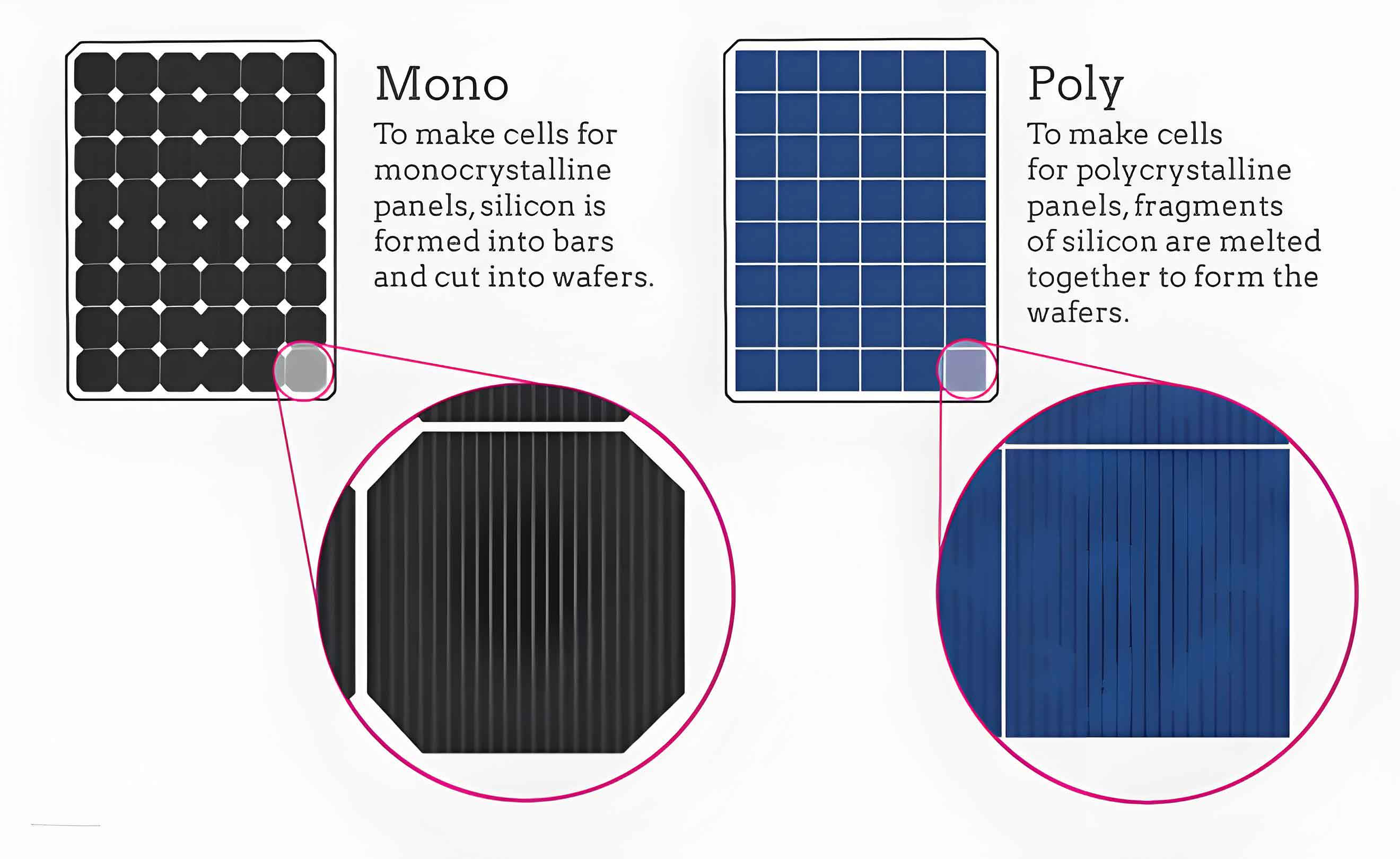Introduction
Solar panels are cornerstone of renewable energy technology, converting sunlight into electricity. Among the various types of solar panels available, monocrystalline and polycrystalline solar panels are the most commonly used for residential, commercial, and industrial applications. Each type has distinct characteristics, advantages, and drawbacks. This article provides a detailed comparative analysis of monocrystalline vs. polycrystalline solar panels, helping consumers make informed decisions based on their specific energy needs and preferences.

Understanding Monocrystalline Solar Panels
Characteristics of Monocrystalline Solar Panels
Monocrystalline solar panels are made from single-crystal silicon. The manufacturing process involves slicing thin wafers from a cylindrical silicon ingot, resulting in uniform and high-purity silicon crystals. This uniformity gives monocrystalline solar panels their characteristic dark black color and high efficiency.
Key Features of Monocrystalline Solar Panels
- High Efficiency: Monocrystalline solar panels are known for their high efficiency rates, typically ranging between 15% and 20%. The single-crystal structure allows for better electron flow, resulting in higher power output.
- Space Efficiency: Due to their higher efficiency, monocrystalline solar panels require less space to generate the same amount of electricity as polycrystalline solar panels. This makes them ideal for installations with limited roof space.
- Durability: Monocrystalline solar panels tend to have a longer lifespan and often come with warranties of 25 years or more. Their durability makes them a long-term investment for sustainable energy production.
- Aesthetic Appeal: The uniform black color of monocrystalline solar panels is often considered more aesthetically pleasing, making them a popular choice for residential installations.
Understanding Polycrystalline Solar Panels
Characteristics of Polycrystalline Solar Panels
Polycrystalline solar panels are made from multiple silicon crystals melted together. This process results in a different crystal structure compared to monocrystalline solar panels, giving polycrystalline solar panels a distinctive blue color with a speckled appearance.
Key Features of Polycrystalline Solar Panels
- Lower Cost: The manufacturing process for polycrystalline solar panels is simpler and less expensive than that for monocrystalline solar panels. This cost advantage makes polycrystalline solar panels more affordable for many consumers.
- Moderate Efficiency: Polycrystalline solar panels generally have lower efficiency rates, typically ranging between 13% and 16%. While they produce less power per square meter, they are still an effective option for many applications.
- Less Waste: The manufacturing process for polycrystalline solar panels produces less silicon waste, making it a more environmentally friendly option in terms of material usage.
- Temperature Sensitivity: Polycrystalline solar panels are more sensitive to high temperatures, which can affect their performance. However, they perform well in moderate climates.
Comparative Analysis
Efficiency and Performance
Monocrystalline solar panels typically offer higher efficiency rates compared to polycrystalline solar panels. This means monocrystalline solar panels can convert a higher percentage of sunlight into electricity, making them more effective in generating power, especially in limited space scenarios.
Cost Considerations
Polycrystalline solar panels are generally more cost-effective due to their simpler manufacturing process. The lower initial investment can make polycrystalline solar panels a more attractive option for budget-conscious consumers.
Space Requirements
Due to their higher efficiency, monocrystalline solar panels require less space to produce the same amount of electricity as polycrystalline solar panels. This makes monocrystalline solar panels more suitable for installations where space is limited.
Aesthetic Appeal
Monocrystalline solar panels have a sleek, black appearance, which many consumers find more visually appealing. In contrast, polycrystalline solar panels have a blue, speckled look that some may find less attractive.
Durability and Lifespan
Both types of solar panels are durable and long-lasting, but monocrystalline solar panels tend to have a longer lifespan and often come with longer warranties. This can be an important consideration for those looking for a long-term investment in solar energy.
Table: Comparison of Monocrystalline vs. Polycrystalline Solar Panels
| Feature | Monocrystalline Solar Panels | Polycrystalline Solar Panels |
|---|---|---|
| Efficiency | 15% – 20% | 13% – 16% |
| Cost | Higher | Lower |
| Space Efficiency | Higher | Lower |
| Aesthetic Appeal | Sleek black color | Blue, speckled appearance |
| Durability | Longer lifespan | Moderate lifespan |
| Temperature Sensitivity | Less sensitive | More sensitive |
| Manufacturing Process | More complex | Simpler |
List of Factors to Consider When Choosing Between Monocrystalline and Polycrystalline Solar Panels
- Budget: Determine your budget for the solar panel installation. Polycrystalline solar panels are generally more affordable.
- Available Space: Evaluate the available space for installation. If space is limited, monocrystalline solar panels’ higher efficiency may be advantageous.
- Aesthetic Preferences: Consider the aesthetic appeal of the solar panels. Monocrystalline solar panels have a sleek, uniform look, while polycrystalline solar panels have a distinctive blue color.
- Energy Needs: Assess your energy requirements. Monocrystalline solar panels produce more electricity per square meter, making them suitable for high energy needs in limited space.
- Climate: Take into account the local climate. Polycrystalline solar panels may be more sensitive to high temperatures, which can affect performance.
- Long-Term Investment: Consider the lifespan and warranty of the solar panels. Monocrystalline solar panels typically have a longer lifespan and come with longer warranties.
Conclusion
The choice between monocrystalline and polycrystalline solar panels depends on various factors, including budget, space availability, aesthetic preferences, energy needs, and climate conditions. Monocrystalline solar panels offer higher efficiency, better space efficiency, and a sleek appearance, making them ideal for installations with limited space and higher energy demands. On the other hand, polycrystalline solar panels are more cost-effective, environmentally friendly in terms of material usage, and a suitable option for those with budget constraints.
By carefully evaluating these factors and understanding the characteristics of each type of solar panel, consumers can make informed decisions that best meet their specific needs and contribute to a sustainable energy future.
